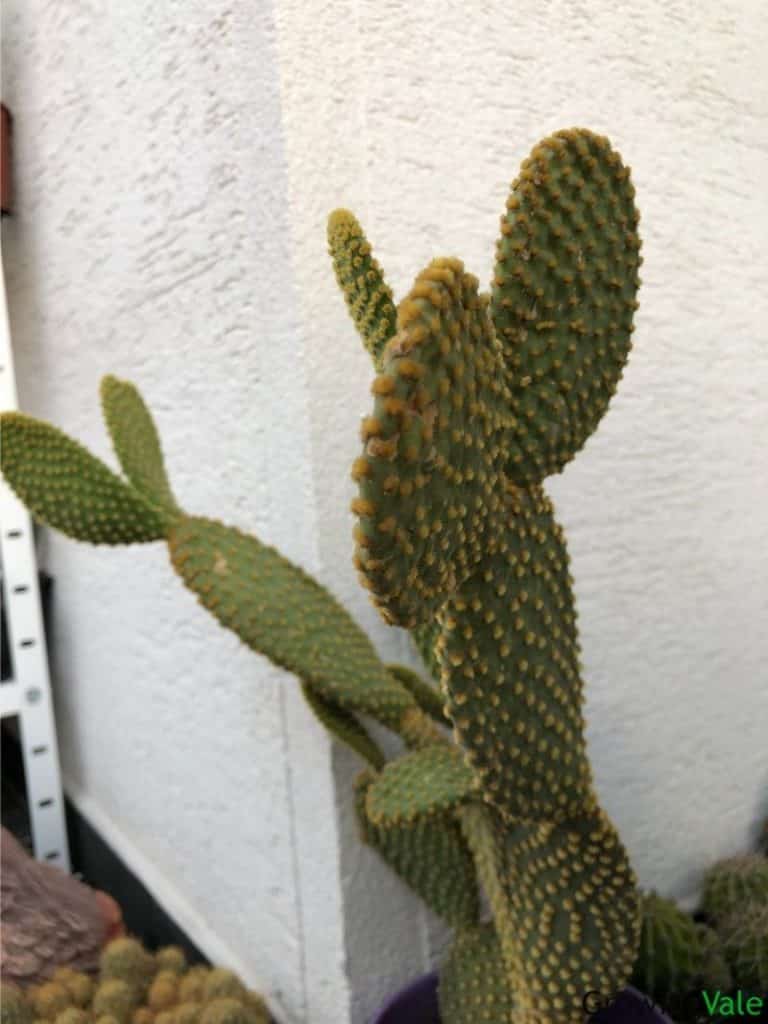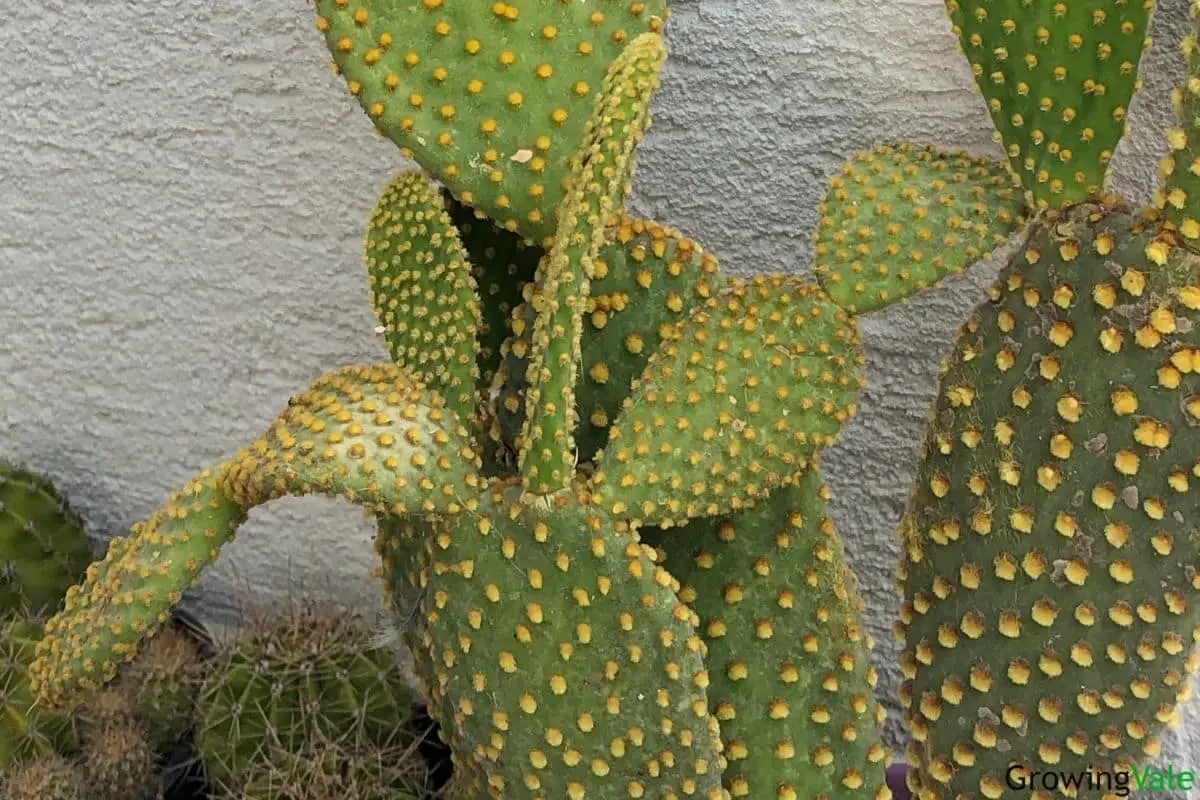The bunny ears cactus belongs to the Opuntia genus, commonly known as prickly pear. This particular species does not grow as tall as other Opuntias but spreads fairly easily.
It’s quite an attractive cactus with elongated tear-shaped pads that are fleshy. This cactus does not have spines but has a multitude of hair-like prickles called glochids. These glochids are golden yellow in color and quite close together. The pads often grow in pairs, hence the common name, bunny ears.
This cactus is very easy to propagate and grow and is very popular with succulent growers around the world. Although this cactus does not commonly flower in cultivation, the flowers are yellow with a red tinge. After flowering, the plant produces green globular fruits that turn dark red when they ripen.
History
Opuntia microdasys was originally found growing in the Southwest Desert of Mexico. It still grows in this region and is quite prolific as it self-propagates very easily. It can be found growing in Hidalgo, Nuevo Leon, San Luis Potosi, Zacatecas, Coahuila, Jalisco, Queretaro and Tamaulipas.
In some countries, like Australia, this cactus is a declared pest when grown outdoors in the ground.
Plant Facts
| Scientific name | Opuntia microdasys |
| Common names | Bunny ear cactus, Angel’s wings, Polka-dot cactus, Golden bristle cactus |
| Genus | Opuntia |
| Family | Cactaceae |
| Height | Up to 2 feet |
| Width | Up to 2 feet |
| USDA Plant Hardiness Zone | 9 to 11 |
| Origin | Mexico |
| Flower colors | Yellow with a red tinge |
| Blooming season | Summer |
| Plant/Flower special features | Both the fruit and the fleshy pads are edible |
How to Grow Bunny Ear Cactus Plant
Opuntia microdasys is very hardy and easy to grow. However, due to its spreading habit and ease of propagation, this is one plant that you should confine to growing in a pot. In its native habitat, it is a prolific spreader as the pads can easily break off and grow into new plants. When grown outdoors in a garden, this species has the potential of becoming a noxious weed if not managed really well.
Opuntia microdasys does make an attractive pot plant, whether grown outdoors or near a bright window inside.
How to Propagate Bunny Ears Cactus
Opuntia microdasys is super easy to propagate from stem cuttings. The pads on this cactus are actually stems and these are used to propagate new plants. When you’re ready to propagate some new plants, gently break off a few of the smaller pads (around 1 inch) at the base. Make sure you wear gloves as the pads are quite prickly. Then, follow these steps:
- Leave your cuttings on a piece of paper towel to dry out for several days.
- Once the cut ends have formed calluses, you can plant the cuttings into a tray filled with cactus potting mix.
- Put these cuttings in a sunny spot and keep the mix moist.
- After only a few days, the cuttings should be starting to form roots.
- You can then pot these into individual containers.

Care and Maintenance
This cactus is low-maintenance and very easy to grow in a pot. Terracotta pots are best because they offer great drainage. The most important thing to remember when growing this cactus is not to overwater it.
Soil
Use a premium cactus mix that is free-draining and contains a lot of grit. The ideal pH range is 5.5 to 7.
Water
Water this cactus consistently during the warmer months and leave it dry over winter. The plant should be allowed to dry out in between watering. Overwatering is one of the main causes of plant death when growing cacti.
Only water your cactus when the top inch of soil feels dry. Then, give it a good drink but let any excess water drain out of the pot. Never let your cactus sit in a saucer full of water.
Therefore, if you’re growing inside and your pots have saucers under them, make sure you empty the saucer after the soil has been allowed to drain every time you water.
During winter, the plant becomes dormant so you only need to give it a light drink every 3 or 4 weeks.
Fertilizer
During spring and summer, your bunny ears cactus will benefit from a light feeding of liquid fertilizer. Make sure you dilute the fertilizer and only use half-strength. Apply this with every second watering during the growing season.

Sunlight
This cactus likes to grow in full sun during the warmer months. Ideally, this plant benefits from at least 14 hours of bright light every day. This is also why growing your cactus in a pot is ideal as you can move it around to get the best light.
However, if you’re growing your cactus indoors and you don’t have a very bright window sill to place it on, you might want to invest in a white fluorescent grow light. This will ensure that the plant gets plenty of light and might encourage it to flower.
During the colder months, the plant becomes dormant and does not need as much light.
Temperature and Humidity
The bunny ears cactus loves the warm weather and a certain amount of humidity. It can tolerate temperatures as high as 100 degrees Fahrenheit (38 degrees Celsius).
For the plant to flower, it requires winter temperatures of around 45 to 55 degrees Fahrenheit (7 to 13 degrees Celsius).
Pruning
This cactus requires no regular pruning.
Pest and diseases
Although not prone to any diseases except root rot if your plant is overwatered, your bunny ears cactus might occasionally attract houseplant pests such as scale and mealybugs.
To get rid of these, treat them with a cotton ball soaked in alcohol. Alternatively, you can spray the plant with some diluted neem oil to kill the pests.
Uses of Bunny Ears Cactus
Like most species of prickly pear, both the fruit and the pads can be eaten. The ripe fruit can be eaten either raw or made into a fruit jelly. The green pads can also be eaten raw or cooked but you have to carefully remove all the prickly glochids first. These are quite easy to pull out with tweezers.
Common Varieties and Cultivars
Opuntia microdasys has a number of subspecies and varieties. These bunny ear cactus types include:
- Opuntia microdasys “albata”
- Opuntia microdasys var. albispina (Angel wings)
- Opuntia microdasys cv. ‘Caress’
- Opuntia microdasys “contorta”
- Opuntia microdasys var. pallida (Polka dot cactus)
- Opuntia microdasys var. pallida f. cristata (Funny bunny, Monstrose bunny ears, or Crested bunny ears)
- Opuntia microdasys subsp. rufida (Cinnamon bunny ears or Blind prickly pear)
Conclusion
The bunny ear cactus plant (angel wing cactus) is an attractive succulent and is ideal for growing in containers. It is extremely low-care and only requires a little watering in the warmer months as well as plenty of exposure to bright light.
The growth pattern of the pads and the fuzzy-looking glochids does give the appearance of fluffy bunny ears. Don’t be fooled by its appearance though as those glochids are very prickly and can be difficult to remove if they get into your fingers.

